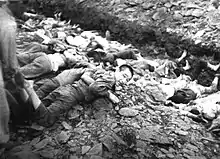Daejeon massacre
The Daejeon, or Taejon, massacre was an extrajudicial killings of political prisoners under anti-communist South Korean forces. US officers were present at the time of the slaughter, however it was blamed on the communist North Korean forces in the film Crime of Korea.[2] Half a century later, the South Korean Truth and Reconciliation Commission investigated what happened in the political violence largely kept hidden from history, unlike the publicized North Korean executions of South Korean right-wingers.[3]
| Daejeon Massacre | |
|---|---|
 Political prisoner lies on the ground before being executed | |
| Location | Daejeon, South Korea |
| Date | June 28, 1950 - July 16, 1950 |
| Target | Communists and suspected communist sympathizers |
Attack type | Massacre |
| Deaths | 4000-7000[1] |
| Perpetrator | South Korean anti-communists |
| Daejeon Massacre | |
| Hangul | 대전형무소 학살 사건 |
|---|---|
| Revised Romanization | Daejeonhyeongmosu Haksal Sageon |
| McCune–Reischauer | Taejonhyungmosu Haksal Sagon |
History
At the end of World War II, Korea was occupied by Soviet and US soldiers and the peninsula was divided at the 38th parallel. The Soviets backed the communist DPRK regime in the North, while the US supported the anti-communist South regime. On June 25, 1950, North Korean soldiers crossed the 38th parallel and invaded South Korea, sparking the Korean War. The ardently anti-communist Syngman Rhee government had arrested thousands of political prisoners and suspected communists and assigned them into the National Guidance Program. As the North Korean army was nearing Daejeon, the South Korean paramilitary forces executed around 7000 political prisoners, men, women, and children in mass graves as American officers took photographs which were kept classified until they were released in 1999.[4][3][5][6]
References
- "The South Korean Massacre at Taejon: New Evidence on US Responsibility and Coverup".
- A/V Geeks (22 June 2014). "Crime of Korea, The (1950)" – via YouTube.
- "AP: U.S. Allowed Korean Massacre In 1950". www.cbsnews.com.
- Editor, Hamish McDonald Asia-Pacific (15 November 2008). "South Korea owns up to brutal past". The Sydney Morning Herald.
{{cite web}}:|last=has generic name (help) - Sang-Hun, Choe (26 November 2009). "South Korean Commission Details Wartime Massacres". The New York Times.
- "Korea Report: The South Korean Massacre at Taejon: New Evidence on US Responsibility and Coverup". 3 September 2008.